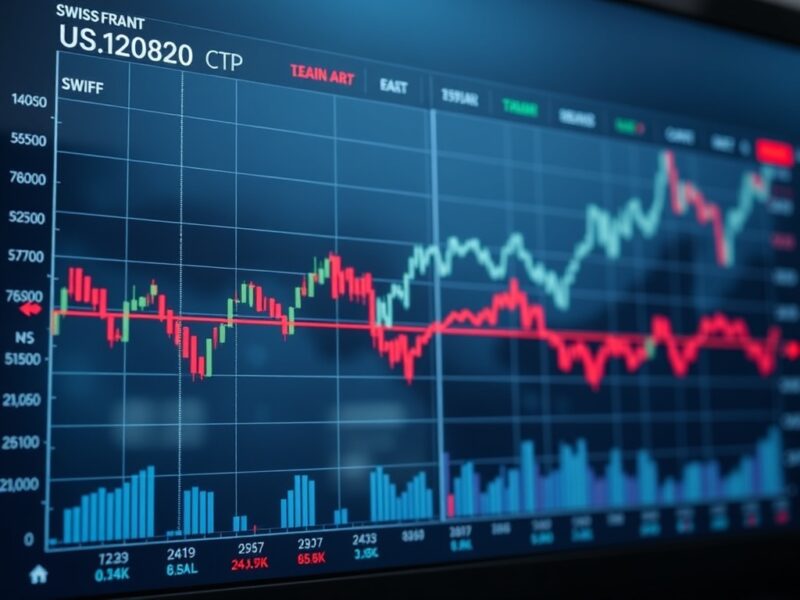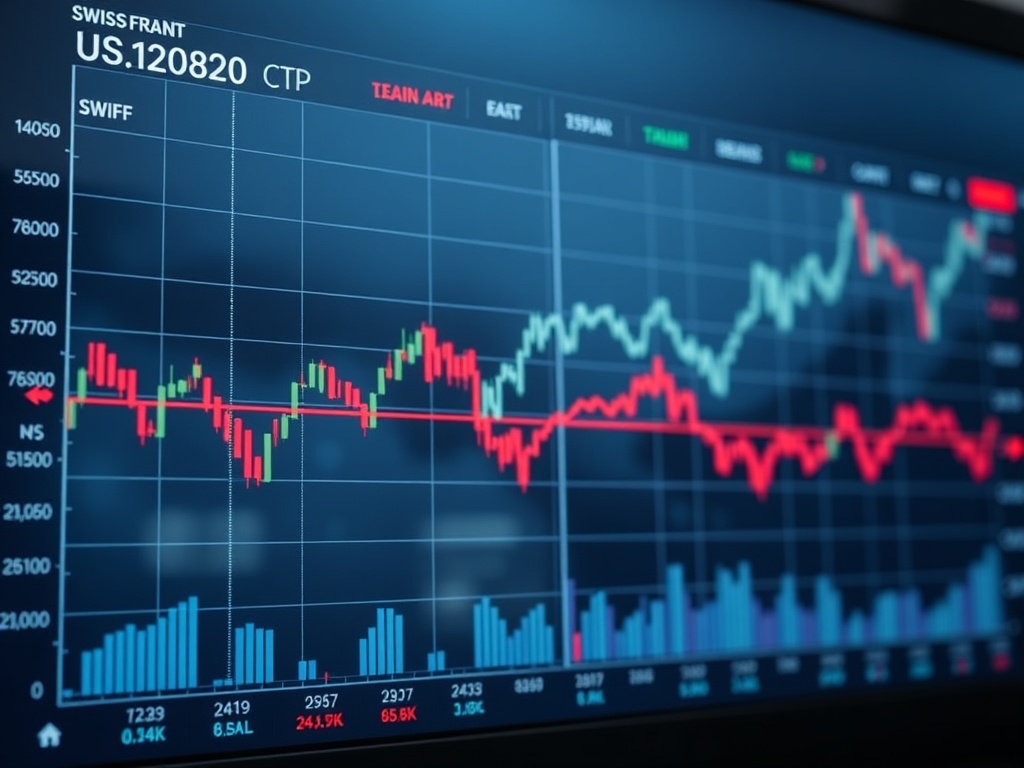Swiss Franc Forecast: UBS Unveils Crucial Outlook Amidst US Tariffs & Fed Policy Shifts
0
0

BitcoinWorld

Swiss Franc Forecast: UBS Unveils Crucial Outlook Amidst US Tariffs & Fed Policy Shifts
In the dynamic world of global finance, every shift in economic policy or geopolitical tension sends ripples across markets, including the often-overlooked yet critically important currency sector. For those invested in cryptocurrencies, understanding these macro-economic currents is paramount, as they often dictate the broader liquidity and risk appetite that influences digital assets. Today, we delve into a significant development from one of the world’s leading financial institutions: UBS’s latest stance on the Swiss franc forecast. Despite the looming shadow of U.S. tariffs and a shifting Federal Reserve policy, UBS maintains its conviction, offering a compelling perspective on what lies ahead for this key safe-haven currency.
Unpacking the Latest Swiss Franc Forecast from UBS
UBS, a titan in global wealth management, has recently reaffirmed its position on the Swiss franc (CHF), signaling a continued belief in its underlying stability despite the turbulent global economic landscape. This is not a simple reaffirmation; it’s a nuanced assessment considering the complex interplay of international trade disputes and central bank strategies. The Swiss franc has historically served as a beacon of stability, often sought after during times of global uncertainty due to Switzerland’s strong economy, political neutrality, and robust financial system.
UBS’s analysis underscores several key drivers influencing their Swiss franc forecast:
- Safe-Haven Appeal: In periods of heightened geopolitical tension or economic slowdown, investors often flock to the CHF, driving up its value.
- Swiss National Bank (SNB) Policy: The SNB’s monetary policy, particularly its stance on interest rates and interventions, plays a crucial role in managing the franc’s strength.
- Current Account Surplus: Switzerland consistently runs a large current account surplus, indicating strong exports and net foreign income, which supports the franc.
Understanding these foundational elements is essential before we explore how external pressures like U.S. tariffs and evolving Fed policy might challenge or reinforce this outlook.
How Do US Tariffs Reshape the Forex Market?
The imposition of US tariffs has become a recurring theme in global trade, creating significant uncertainty and volatility across various asset classes, including currencies. Tariffs, essentially taxes on imported goods, are designed to protect domestic industries but often lead to retaliatory measures, escalating trade wars. For the Forex market, the impact is multifaceted:
- Risk Aversion: Trade tensions increase global economic uncertainty, prompting investors to shun riskier assets and seek refuge in traditional safe havens like the U.S. dollar, Japanese yen, and the Swiss franc.
- Supply Chain Disruptions: Tariffs can disrupt global supply chains, affecting corporate profits and economic growth, which in turn influences a country’s currency strength.
- Inflationary Pressures: Tariffs can lead to higher import costs, potentially fueling inflation. Central banks may then adjust monetary policy in response, impacting currency valuations.
While U.S. tariffs directly impact trade relationships, their ripple effect on global growth prospects and investor sentiment indirectly strengthens demand for currencies perceived as stable. This dynamic is a key consideration in the UBS outlook for the CHF, as escalating trade disputes could further bolster its safe-haven appeal.
Decoding Fed Policy: A Critical Factor for Currency Stability
The monetary policy decisions of the U.S. Federal Reserve are arguably the single most influential factor in global financial markets, with profound implications for every major currency, including the Swiss franc. The Fed policy on interest rates, quantitative easing, and inflation targets sets the tone for global liquidity and investment flows. When the Fed signals a shift in its stance, the U.S. dollar (USD) reacts, and given the USD’s status as the world’s primary reserve currency, this reverberates throughout the entire Forex market.
Consider these aspects of Fed policy influence:
- Interest Rate Differentials: A higher Fed interest rate relative to other central banks (like the SNB) makes dollar-denominated assets more attractive, potentially drawing capital away from other currencies, including the CHF. Conversely, if the Fed signals rate cuts, the USD might weaken, indirectly strengthening other currencies.
- Global Liquidity: The Fed’s balance sheet policies (quantitative easing or tightening) directly impact global liquidity. Abundant liquidity can flow into riskier assets, while tightening can lead to a ‘dash for cash’ and strengthen the USD.
- Economic Outlook: The Fed’s assessment of the U.S. economic outlook influences investor confidence globally. A strong U.S. economy can pull global growth, affecting all currencies.
UBS’s maintained Swiss franc forecast suggests they anticipate the CHF’s intrinsic strengths will help it weather potential headwinds from Fed policy shifts, perhaps even benefiting from a weaker dollar if the Fed adopts a more dovish stance.
The UBS Outlook: Navigating Intersecting Economic Forces
The true genius of the UBS outlook lies in its ability to synthesize these disparate yet interconnected economic forces – U.S. tariffs and Fed policy – into a cohesive Swiss franc forecast. It’s not merely about predicting the CHF’s direction in isolation but understanding how it reacts within a complex global system. UBS likely employs sophisticated models that weigh the probabilities of various scenarios:
| Scenario | US Tariffs Impact | Fed Policy Impact | Expected CHF Response |
|---|---|---|---|
| Escalating Trade War | Increased global uncertainty, reduced trade volumes. | Likely dovish (rate cuts) to support growth. | Stronger CHF (safe-haven demand), potentially against a weaker USD. |
| De-escalation & Growth | Improved global sentiment, increased trade. | Likely neutral/hawkish (stable rates) amid growth. | Weaker CHF (reduced safe-haven demand) as risk appetite returns. |
| Stagflationary Fears | Supply shocks from tariffs, high inflation. | Complex dilemma: combat inflation vs. support growth. | Volatile CHF, potentially strong if safe-haven demand outweighs inflation concerns. |
This table illustrates how UBS’s continued positive Swiss franc forecast might stem from a belief that the safe-haven demand generated by trade tensions could offset any negative pressure from Fed policy, or even be amplified if the Fed is forced to cut rates.
Challenges and Opportunities in the Current Forex Market
The current environment, shaped by persistent US tariffs and an evolving Fed policy, presents both significant challenges and unique opportunities for participants in the Forex market. Understanding these dynamics is crucial for making informed decisions.
Challenges:
- Increased Volatility: Sudden announcements regarding trade or monetary policy can trigger rapid currency swings, making risk management complex.
- Unpredictable Economic Data: The impact of tariffs on global supply chains and inflation can distort traditional economic indicators, making forecasting more difficult.
- Policy Divergence: Central banks may adopt divergent policies, leading to unpredictable capital flows and currency movements.
Opportunities:
- Safe-Haven Plays: Currencies like the Swiss franc offer opportunities for capital preservation during times of global stress.
- Diversification: Including stable currencies in a diversified portfolio can help mitigate overall risk, especially for those heavily exposed to other asset classes like equities or even volatile cryptocurrencies.
- Interest Rate Arbitrage: While risky, careful analysis of interest rate differentials, influenced by Fed policy, can present opportunities for carry trades.
The continued UBS outlook on the CHF suggests that for astute investors, the challenges can be navigated, and opportunities can be seized, particularly by focusing on assets with intrinsic stability.
Actionable Insights for Investors
Given the intricate dance between the Swiss franc forecast, US tariffs, and Fed policy, what steps can investors take to position themselves effectively in the Forex market?
- Monitor Global Trade Developments Closely: Pay attention to news on trade negotiations and tariff implementations. Escalation typically boosts safe havens like the CHF, while de-escalation may reduce its appeal.
- Track Federal Reserve Communications: Follow FOMC meeting minutes, speeches by Fed officials, and economic projections. Signals about future rate changes or quantitative easing/tightening will significantly impact the USD and, consequently, other major currencies.
- Consider CHF as a Portfolio Stabilizer: For those looking to diversify or hedge against broader market volatility, a strategic allocation to the Swiss franc, in line with the UBS outlook, could be beneficial. It can act as a counterbalance during periods of equity market downturns or geopolitical crises.
- Implement Robust Risk Management: Given the potential for sudden shifts, utilize stop-loss orders and position sizing to manage exposure. Avoid over-leveraging, especially in a volatile currency market.
- Consult Financial Professionals: The currency market is complex. Seeking advice from financial advisors who specialize in forex can provide tailored strategies based on your risk tolerance and investment goals.
These insights underscore the importance of vigilance and strategic planning in navigating the evolving global financial landscape.
Conclusion: What Lies Ahead for the Swiss Franc?
UBS’s decision to maintain its Swiss franc forecast is a testament to the currency’s enduring resilience in the face of significant global headwinds. While the ongoing specter of US tariffs and the evolving stance of Fed policy undoubtedly introduce layers of complexity and potential volatility, the CHF’s fundamental role as a safe haven appears to be a consistent anchor. The Forex market remains a fascinating arena where macro-economic forces play out in real-time, offering both risks and rewards. For investors, particularly those accustomed to the rapid shifts in the crypto world, understanding these traditional market dynamics is crucial. The UBS outlook suggests that despite the external pressures, the Swiss franc is poised to retain its value, continuing to be a critical component in the global financial architecture. As these powerful forces continue to shape the world economy, the Swiss franc will undoubtedly remain a currency to watch.
To learn more about the latest Forex market trends, explore our article on key developments shaping currency liquidity and institutional adoption.
This post Swiss Franc Forecast: UBS Unveils Crucial Outlook Amidst US Tariffs & Fed Policy Shifts first appeared on BitcoinWorld and is written by Editorial Team
0
0
 Manage all your crypto, NFT and DeFi from one place
Manage all your crypto, NFT and DeFi from one placeSecurely connect the portfolio you’re using to start.




